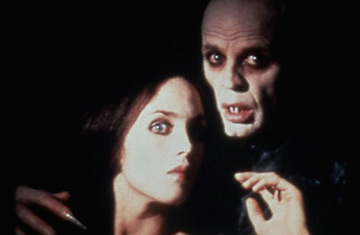
Nosferatu
1922; Director: F.W. Murnau; Writer: Henrik Galeen, from the novel Dracula by Bram Stoker
With Max Schreck, Gustav von Wagenheim, Greta Schroeder, Ruth Landshoff, Alexander Granach
Kino International
Available Nov. 20, List Price $29.95
Nosferatu! the film's introductory title card reads. Does this word not sound like the death bird calling your name at midnight? Beware you never say it, for then the pictures of life will fade to shadows. Haunting dreams will climb forth from your heart and feed on your blood.
Stoker wrote his vampire as a courtly count, incarnated with lugubrious relish by Bela Lugosi in the 1930 Hollywood version. Dracula really should be seductive; charm will get him close enough to women to bite their necks and drain their blood. He is the embodiment of the moral of most horror movies: that sex equals death. The genre was always a mix of the prurient and the puritanical: first tease viewers with an erotic come-on, then punish them by showing its consequences.
But the makers of this silent masterpiece — Murnau, Galeen, cinematographer F.A. Wagner and the production designer Albin Grau, who brought Murnau onto the project saw Dracula as something more elemental, atavistic. Their count, whom they called Orlok, is a pestilential creature, more rodent than man: King Rat. The vermin that accompany him are not his acolytes but his siblings. As played by the suitably named Shreck (the German word for fear), he represents a moral and physical deformity the civilized world tolerates at its peril.
Because the producers made the film without troubling to get the rights, and were subsequently sued by Stoker's widow, Nosferatu was not widely seen in good prints. Yet its quality, and its standing as the first important Dracula movie, attracted admirers. Werner Herzog remade it in 1979, with Klaus Kinski starring. Elias Merhige's Shadow of the Vampire was a making-of-Nosferatu fantasia that cast Willem Dafoe in the Shreck role, and imagined that the actor was in fact a vampire. (We also fondly recall episode 413 of Mystery Science Theater 3000, in which a spooky hospital worker is referred to as Nurse Feratu.) Beyond the horror elements, it's worth seeing for the early flowering of Murnau's artistry. He was one of the genius directors of the silent era, and this is his first great film.
The film is subtitled A Symphony of Horror, and this edition, splendidly restored by Luciano Berriatua for the Murnau Foundation, not only looks great, it has a new orchestration of Hans Erdman's original score. The antique classic is alive again (not undead), in all its pristine, tinted glory. Eighty-five years later, you'll get the same chill the film's first audiences felt when, in a climactic shot, the black shadow of Orlok's hand slowly creeps up the heroine's white dress, then makes a sudden grasping gesture as she convulses in terror. That's the power of movies in their purest form: a moving shadow that can touch and clutch the heart.